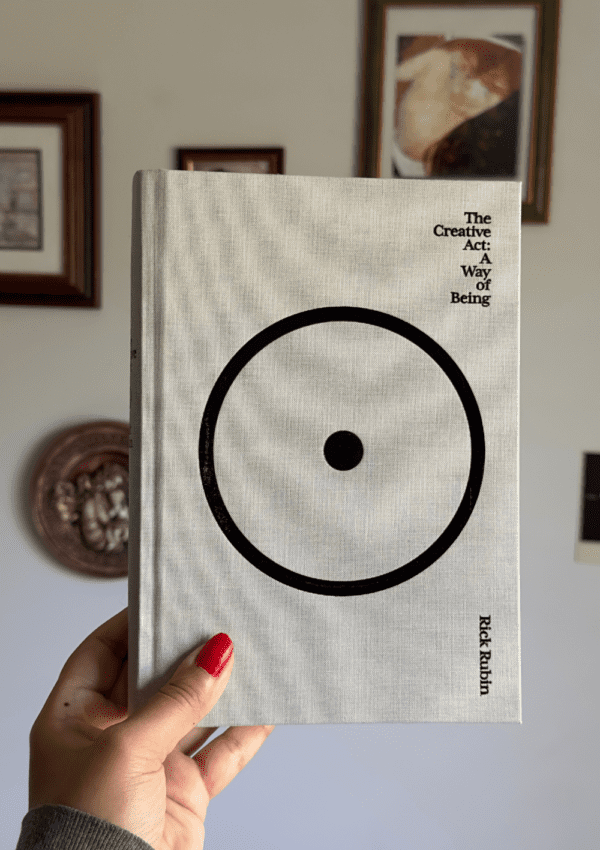This post may contain affiliate links, which means I’ll receive a commission if you purchase through my links, at no extra cost to you. Please read my full disclosure for more information.

To begin with, the book “The Power of Now: A Guide to Spiritual Enlightenment” by Eckhart Tolle is a philosophical self-help guide published in 1997.
I personally discovered this book through a friend’s recommendation. Taking one look at the title, I said that this one is not for me. I told my friend that I don’t think I will be able to keep an open mind while reading this. He told me to try it and that I won’t regret it.
And so I did, and now I have learned so many life long lessons from this guide. I am better able to focus in the present moment and allow myself to be happier.
The reason I ended up thoroughly enjoying and valuing this book is because it focuses on the “Being” instead of the “Ego.” Therefore, this self-help guide shows how to separate ourselves from our ego identity, since it is harming us.
In order to focus instead on our Being, we need to be conscious of the present moment. Hence, it is “The Power of Now.”
It is not about being passive or unproductive, it is about understanding the situation you are in and to inhabit the mental-spiritual space of the here and now. Without all that resistance, I believe Tolle is right in saying that life becomes much easier, more peaceful. It is not defeat but simple recognition in the purest form of acceptance.
Here are the 10 life lessons, I personally highlighted, from “The Power of Now: A Guide to Spiritual Enlightenment” by Eckhart Tolle. These lessons will help you focus in the present and consequently, to become happier.
Life lesson #1: Disidentify from your mind
All of our suffering is coming from the content need to identify with the thoughts in our mind. These thoughts result in judgment, fear, shame, suffering, etc., which causes us daily stress.
According to Tolle, it is what separates us from others rather than bringing us closer together. Yet, ironically we are all suffering from this mind-identity identification.
“Identification with your mind, which causes thought to become compulsive. Not to be able to stop thinking is a dreadful affliction, but we don’t realize this because almost everybody is suffering from it, so it is considered normal. This incessant mental noise prevents you from finding that realm of inner stillness that is inseparable from Being. It also creates a false mind-made self that casts a shadow of fear and suffering.”
Tolle points at this “mental noise” that we have accepted and that is making us miserable. We believe what we think. This is wrong and harmful. As a result, we constantly want to believe that everything we think is right.
Thus, “Once you have disidentified from your mind, whether you are right or wrong makes no difference to your sense of self at all, so the forcefully compulsive and deeply unconscious need to be right, which is a form of violence, will no longer be there.”
Life lesson #2: Overthinking is a disease
Consequently, if thoughts are compulsive; overthinking is a disease. Tolle cleverly explains this notion analogously with the cells of our bodies:
“Thinking has become a disease. Disease happens when things get out of balance. For example, there is nothing wrong with cells dividing and multiplying in the body, but when this process continues in disregard of the total organism, cells proliferate and we have disease.”
Therefore, the mind can become an instrument of great capacity and strength but it can also serve for destruction:
“The mind is a superb instrument if used rightly. Used wrongly, however, it becomes very destructive. To put it more accurately, it is not so much that you use your mind wrongly you usually don’t use it at all. It uses you. This is the disease.”
SEE ALSO: 10 Crucial Life Lessons from Jon Krakauer’s Book “Into the Wild”
Life lesson #3: Stillness allows for creative thinking
Admittedly, when we become present in the moment, in the Now, we allow a stillness in our minds.
“Enlightenment means rising above thought, not filling back to a level below thought, the level of an animal or a plant. In the enlightened state, you still use your thinking mind when needed, but in a much more focused and effective way than before. You use it mostly for practical purposes, but you are free of the involuntary internal dialogue, and there is inner stillness.”
These moments of stillness actually allows us to think more creatively. This is why a lot of people turn to meditation and practices that allow room for this stillness of mind where no harmful thoughts can permeate. It takes lots of concentration and practice. But, Tolle affirms that:
“When you do use your mind, and particularly when a creative solution is needed, you oscillate every few minutes or so between thought and stillness, between mind and no-mind. No-mind is consciousness without thought. Only in that way is it possible to think creatively, because only in that way does thought have any real power. Thought alone, when it is no longer connected with the much vaster realm of consciousness, quickly becomes barren, insane, destructive.”
Thus, thought can only have power when it has been brought to the conscious mind and not brooding obsessively under the surface. Only then, can it be used creatively rather than destructively.
Life lesson #4: Stop resisting pain
Furthermore, Tolle explains that the resistance we experience towards the present moment is what causes us pain.
“The pain that you create now is always some form of nonacceptance, some form of unconscious resistance to what is. On the level of thought, the resistance is some form of judgment. On the emotional level, it is some form of negativity. The intensity of the pain depends on the degree of resistance to the present moment, and this in turn depends on how strongly you are identified with your mind. The mind always seeks to deny the Now and to escape from it.”
By letting go and by not presenting resistance from the moment; you save yourself from pain.
“In other words, the more you are identified with your mind, the more you suffer. Or you may put it like this: the more you are able to honor and accept the Now, the more you are free of pain, of suffering and free of the egoic mind. Why does the mind habitually deny or resist the Now? Because it cannot function and remain in control without time, which is past and future, so it perceives the timeless Now as threatening. Time and mind are in fact inseparable.”
Additionally, it is by separating your mind from the pain-body that you allow yourself to be in the present moment. Tolle writes:
“Let me summarize the process. Focus attention on the feeling inside you. Know that it is the pain-body. Accept that it is there. Don’t think about it don’t let the feeling turn into thinking. Don’t judge or analyze. Don’t make an identity for yourself out of it. Stay present, and continue to be the observer of what is happening inside you. Become aware not only of the emotional pain but also of “the one who observes,” the silent watcher. This is the power of the Now, the power of your own conscious presence. Then see what happens.”
Life lesson #5: Let go of the fear of death
All the fear that we experience in our lives – and that adds to our day to day stresses – all comes down to one deep inevitable fear. The fear of death.
“Fear seems to have many causes. Fear of loss, fear of failure, fear of being hurt, and so on, but ultimately all fear is the ego’s fear of death, of annihilation. To the ego, death is always just around the corner. In this mind-identified state, fear of death affects every aspect of your life.”
In this matter, our egos are deeply tied to this fear of death. We feel like we cannot have our ego be under attack. Fear attacks our ego constantly and with zero remorse.
“For example, even such a seemingly trivial and “normal” thing as the compulsive need to be right in an argument and make the other person wrong defending the mental position with which you have identified is due to the fear of death. If you identify with a mental position, then if you are wrong, your mind-based sense of self is seriously threatened with annihilation. So you as the ego cannot afford to be wrong. To be wrong is to die. Wars have been fought over this, and countless relationships have broken down.”
Life lesson #6: Embrace the silence
In order to accept this fear of death, to stop resisting pain and the mental torture that is our thoughts, we need to embrace the silence Tolle instructs:
“To listen to the silence, wherever you are, is an easy and direct way of becoming present. Even if there is noise, there is always some silence underneath and in between the sounds. Listening to the silence immediately creates stillness inside you. Only the stillness in you can perceive the silence outside. And what is stillness other than presence, consciousness freed from thought forms?”
Life lesson #7: Get rid of the egoic mind
Ego can be destructive. It is a truth we have known far beyond from Freudian psychology. We know that a big ego is destructive. This is why Tolle reminds us that we need to separate from our egoic mind:
“But as long as you are run by the egoic mind, you are part of the collective insanity. Perhaps you haven’t looked very deeply into the human condition in its state of dominance by the egoic mind. Open your eyes and see the fear, the despair, the greed, and the violence that are all-pervasive. See the heinous cruelty and suffering on an unimaginable scale that humans have inflicted and continue to inflict on each other as well as on other life forms on the planet. You don’t need to condemn. Just observe. That is sin. That is insanity. That is unconsciousness. Above all, don’t forget to observe your own mind. Seek out the root of the insanity there.”
Life lesson #8: Love yourself
In order not to ruin your relationships, you need to be able to love and find comfort in yourself first. If you do not face your deep rooted problems, you risk the chance to project your worries and your insecurities onto your partner or any form of supportive, intimate relationship you form.
Tolle warns that you will swap this discomfort with yourself by being surrounded by other people instead. This is not healthy and it is not helpful when trying to build strong long lasting relationships:
“If you cannot be at ease with yourself when you are alone, you will seek a relationship to cover up your unease. You can be sure that the unease will then reappear in some other form within the relationship, and you will probably hold your partner responsible for it. All you really need to do is accept this moment fully. You are then at ease in the here and now and at ease with yourself.”
You have to release yourself from judgment, criticism, and self-pity in order to accept and love yourself. Tolle instructs that you have to remedy yourself from the split the self creates when you are in a relationship with yourself. He writes that your self splits into the “I” and “myself,” and thus, into the subject and the object. According to Tolle, this duality of the mind creates unnecessary complexity:
“That mind-created duality is the root cause of all unnecessary complexity, of all problems and conflict in your life. In the state of enlightenment, you are yourself “you” and “yourself” merge into one. You do not judge yourself, you do not feel sorry for yourself, you are not proud of yourself, you do not love yourself, you do not hate yourself, and so on. The split caused by self-reflective consciousness is healed, its curse removed. There is no “self” that you need to protect, defend, or feed anymore. When you are enlightened, there is one relationship that you no longer have: the relationship with yourself. Once you have given that up, all your other relationships will be love relationships.”
Life lesson #9: Strive for peace (if you cannot be happy)
Truth be told, we cannot always be happy. It just isn’t how life works. Bad things happen all the time and they make us miserable. They make us incredibly unhappy. Yet, Tolle says if you accept the negative emotions, you can move past them. You won’t be necessarily happy, but you will be more at peace.
“For example, when a loved one has just died, or you feel your own death approaching, you cannot be happy. It is impossible. But you can be at peace. There may be sadness and tears, but provided that you have relinquished resistance, underneath the sadness you will feel a deep serenity, a stillness, a sacred presence. This is the emanation of Being, this is inner peace, the good that has no opposite.”
Consequently, it is resistance of the mind at the negative emotion or experience that creates the heavy weight of misery. It keeps you from being at peace.
“What if it is a situation that I can do something about? How can I allow it to be and change it at the same time?” Do what you have to do. In the meantime, accept what is. Since mind and resistance are synonymous, acceptance immediately frees you from mind dominance and thus reconnects you with Being.”
Life lesson #10: Free yourself from negativity
Finally, if you surrender yourself to the present moment, your mind becomes free from negativity. Your mind finally stops resisting. Additionally, “Whenever you notice that some form of negativity has arisen within you, look on it not as a failure, but as a helpful signal that is telling you: “Wake up. Get out of your mind. Be present.”
You need to accept “what is,” writes Tolle. In life, things “go wrong” often. It becomes easier when you accept “the flow of life.” Since, “Acceptance of What is immediately frees you from mind identification and thus reconnects you with Being.”
However, Tolle is not saying to remain passive of a situation that you can change. He is simply saying not to emotionally tie your Being to the Ego that feels under-attack. You need to try to remain that inner peace at all times.
“For example, if you were stuck in the mud somewhere, you wouldn’t say. “Okay, I resign myself to being stuck in the mud.” Resignation is not surrender. You don’t need to accept an undesirable or unpleasant life situation. Nor do you need to deceive yourself and say that there is nothing wrong with being stuck in the mud. No. You recognize fully that you want to get out of it. You then narrow your attention down to the present moment without mentally labeling it in any way. This means that there is no judgment of the Now. Therefore, there is no resistance, no emotional negativity. You accept the “isness” of this moment. Then you take action and do all that you can to get out of the mud. Such action I call positive action. It is far more effective than negative action, which arises out of anger, despair, or frustration. Until you achieve the desired result, you continue to practice surrender by refraining from labeling the Now.”
Therefore, you allow room for positive action when you accept the present moment unconditionally.
To conclude, I will leave you with Tolle’s insightful visual analogy to represent “The Power of Now”:
“You are walking along a path at night, surrounded by a thick fog. But you have a powerful flashlight that cuts through the fog and creates a narrow, dear space in front of you. The fog is your life situation, which includes past and future; the flashlight is your conscious presence; the dear space is the Now.”
- What is Autofiction? (5 Autofiction Novels To Read)
- 8 Classic Fall Books to Read this Fall
- 20 Best Fall Books You Need to Read this Autumn
- Why You Should Take a Social Media Break (6 Big Mental Health Reasons)
- Top 7 Books for Entrepreneurs
Like the post? Save Pin for later!









It’s a shame you don’t have a donate button! I’d certainly donate to this outstanding blog!
I guess for now i’ll settle for book-marking and adding your RSS feed to my Google account.
I look forward to fresh updates and will talk about this site with my Facebook group.
Talk soon!